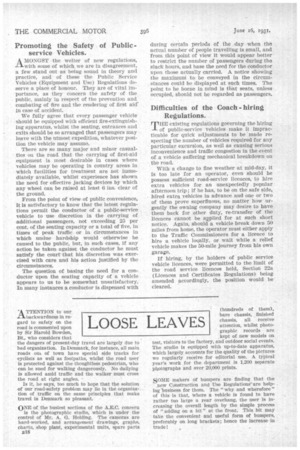Promoting the Safety of Public service Vehicles.
Page 36

If you've noticed an error in this article please click here to report it so we can fix it.
-LaA MONGST the welter of new regulations, with some of which we are in disagreement, a few stand out as being sound in theory and practice, and of these the Public Service Vehicles (Equipment and Use) Regulations deserve a place of honour. They are of vital importance, as they concern the safety • of the public, mainly in respect of the prevention and combating of fire and the rendering of first aid' in case of accident.
We fully agree that every passenger vehicle should be equipped with efficient fire-extinguishing apparatus, whilst the seating, entrances and exits should be so arranged that passengers may leave with the utmost expedition, whatever position the vehicle may assume.
There are so many major and minor casualties on the road that the carrying of first-aid equipment is most desirable in cases where vehicles may be operating in country areas in which facilities for treatment are not immediately available, whilst experience has shown the need for effective jacking devices by which any wheel can be raised at least 6 ins, clear of the ground.
From the point of viewof public convenience, it is satisfactory to know that the latest regulations permit the conductor of a public-service vehicle to use discretion in the carrying of additional passengers, not exceeding 25 per cent of the seating capacity or a total of five, in times of peak traffic or in circumstances in which .undue hardship would otherwise be caused to the public, but, in such cases, if any action be taken against the conductor he must satisfy the court that his. discretion was exercised with care and his action justified by the circumstances.
The question of basing the need for a conductor upon the seating capacity of a vehicle appears to us to be somewhat unsatisfactory. In many instances a conductor is dispensed with during certain periods a the day when the actual number of people travelling is small, and from this point of view it would appear better to restrict the number of passengers during the slack hours, and base the need for the conductor upon those actually carried. A notice showing the maximuiri to be conveyed in the circumstances could be displayed at such times. The point to he borne in mind is that seats, unless occupied, should not be regarded as passengers.




































































































